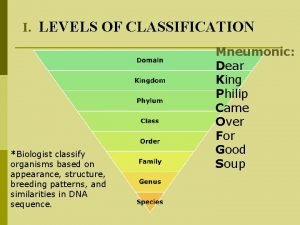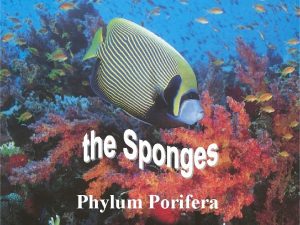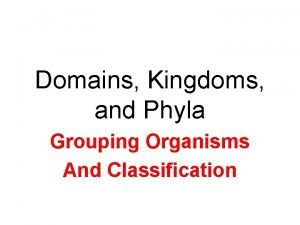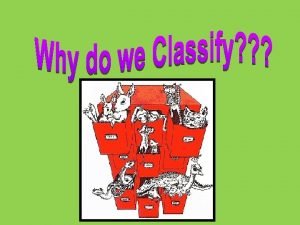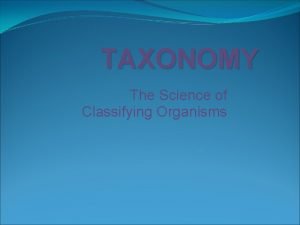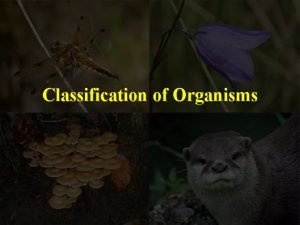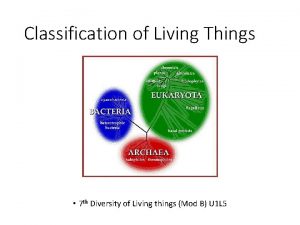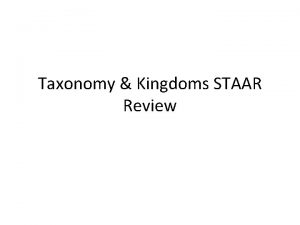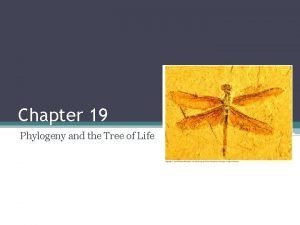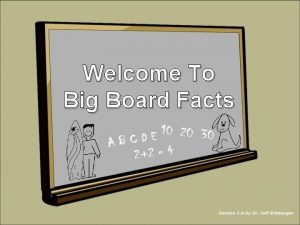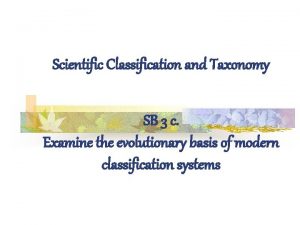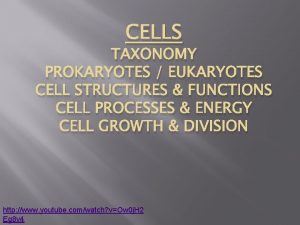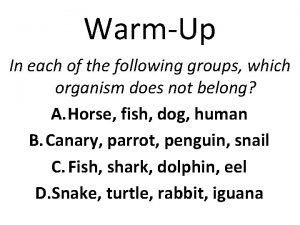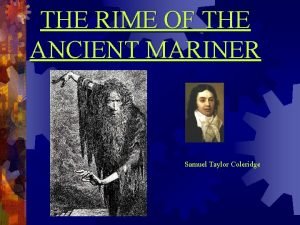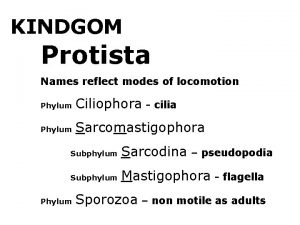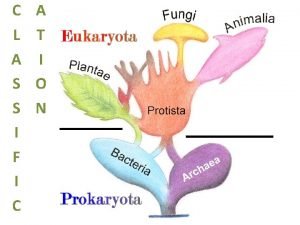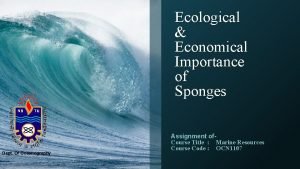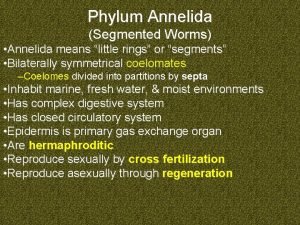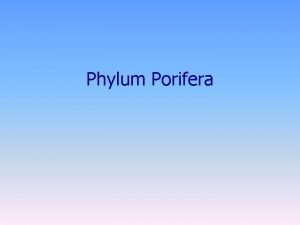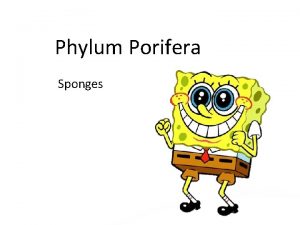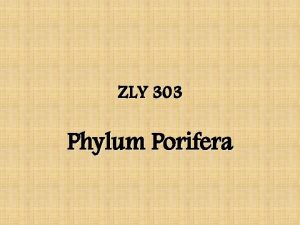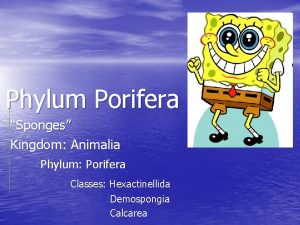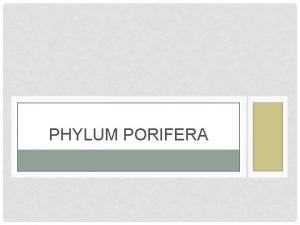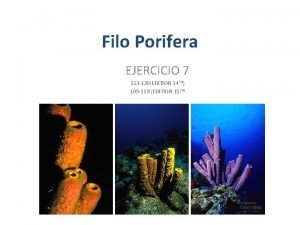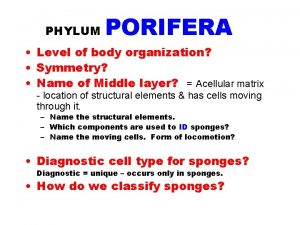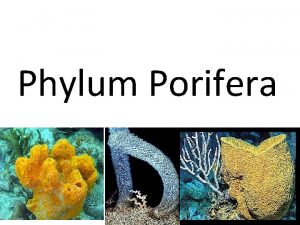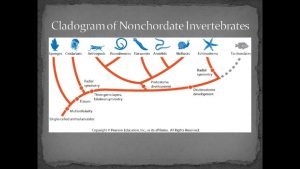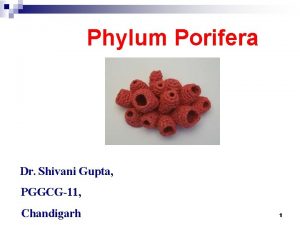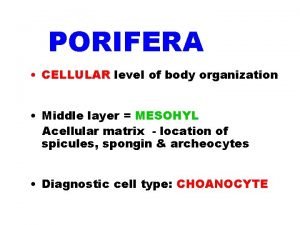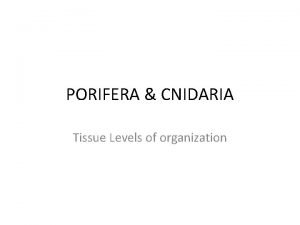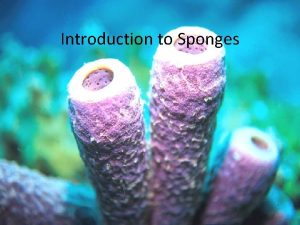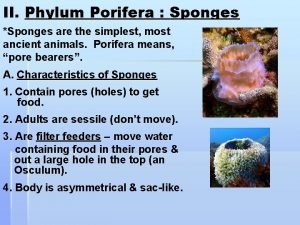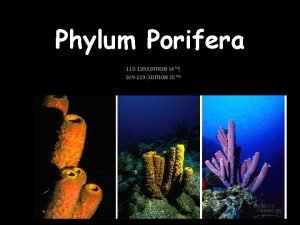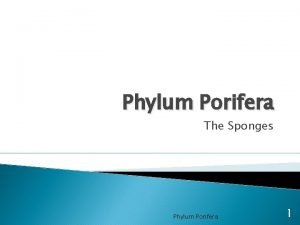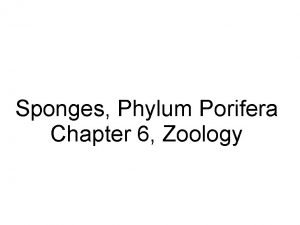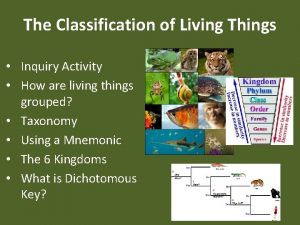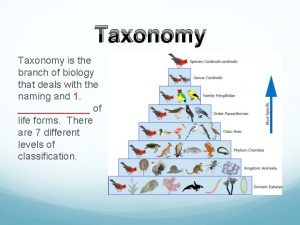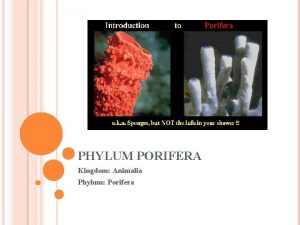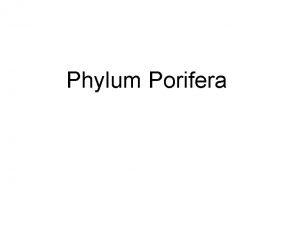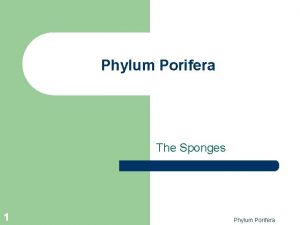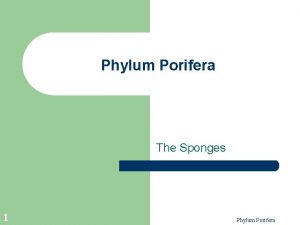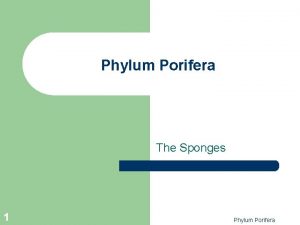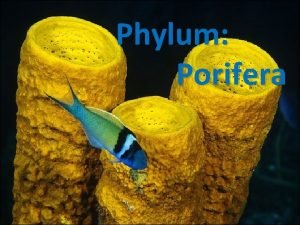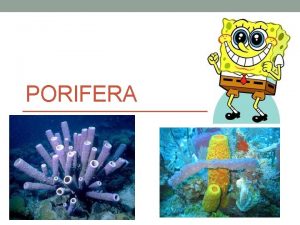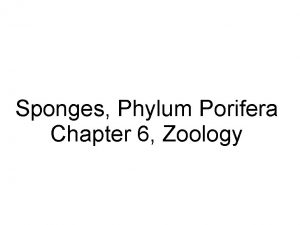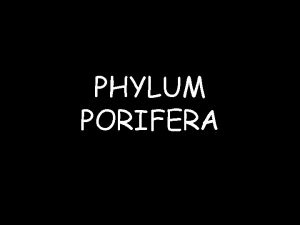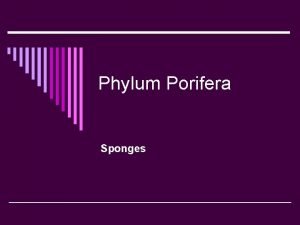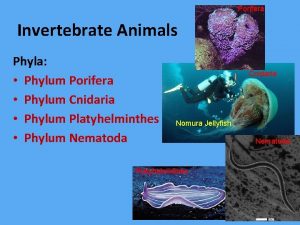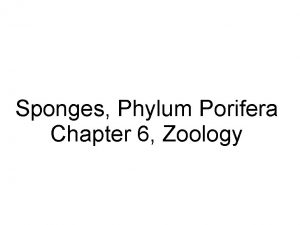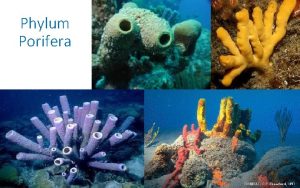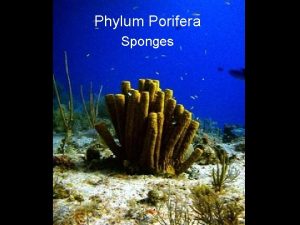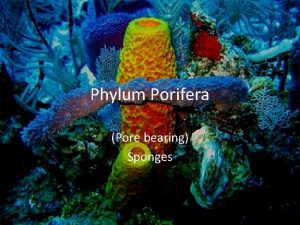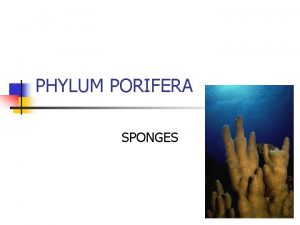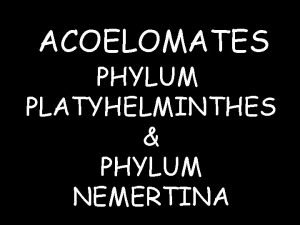Phylum Porifera Taxonomic Referencing King Philip Came Over











































- Slides: 43

Phylum Porifera

Taxonomic Referencing • King Philip Came Over For Good Soup • (Kingdom, Phylum, Class, Order, Family, Genus, Species)

Tree of Life

Tree of Life

Tree of Life • Protozoans – Animals whose bodies consist of single cells • Metazoans - Animals whose bodies consist of many cells

General Information • Kingdom : Animalia • Phylum : Porifera • Porifera = “pore bearer” Yellow barrel sponge Pink lumpy sponge

Phylum Porifera

General Information Size range: 1 cm to 2 m in diameter Giant Barrel sponges

General Information • They are without organs, mouth, digestive system or nervous tissue

Body Structure Ostia – small pores where water enters Oscullum – large hole through which water flows to deliver food, oxygen and carry away waste products


Body Structure • Collar Cells – cells bearing flagella that maintain a steady current of water through the sponge • Amoebocytes – transport food to other cell layers


Body Structure • Spicules – skeleton of the sponge, secreted by amebocyte cells; made of calcium carbonate or silica • Spongin – flexible protein, holds cells together

Level of organization *Body composed of cells, not tissues Japanese Deep Sea Sponge

Habitat -Both marine and freshwater -Both tropical and polar climates Purple Rope sponge Fresh-water Sponge

Youtube Video • Wonderful World of Sea Sponges • http: //www. youtube. com/watch? v=BW 05 v Mziy 2 o

Feeding -Sponges are heterotrophic; considered filter feeders. -Filter Feeder - organism which obtains nutrition by filtering small food particles from water

Feeding Process 1. Water & food goes in via ostia 2. Choanocytes (collar cells) trap food 3. Amoebocytes transfer food to other cells 4. Water exits through oscullum

Sponge Feeding • http: //www. youtube. com/watch? v=T 7 E 1 rq 7 z. HLc&NR=1

Respiration -Through diffusion

Internal transport • Through diffusion

Response • NONE ! • No nervous system Pipe organ sponge

Locomotion – movement or motility -Larvae are free-swimming, use cilia -Adults are sessile (do not move)

Regeneration • Tremendous ability to repair and restore lost parts • Can also rebuild self if totally disintegrated

Reproduction -Porifera have both sexual and asexual reproduction 1. Asexual - budding

Reproduction • • 2. Sexual a. Most monoecious = hermaphrodites, both sexes in same organism Egg & sperm produced Self fertilization results in free-swimming larvae

Reproduction 2. Sexual b. Some dioecious – have separate sexes • Egg OR sperm produced • Cross fertilization results in larvae • Larvae settles on sea floor to become adult

Sponge Reproduction • http: //www. youtube. com/watch? v=KOFFz XNYJG 0&feature=related


Ecological Roles A. Create habitat for other organisms A. B. Food source for some

Sea Turtle Feeding on Sponge • http: //www. youtube. com/watch? v=tl_gje. XK Dps&feature=related

Ecological Roles Home use: the bath sponge bathing, cleaning

Ecological Roles Medical research - Sponges don’t get cancer. -Why not? Maybe we can use what keeps them from getting cancer to treat humans………. .

Azure Vase Sponge

Giant Barrel Sponge

Elephant Ear Sponge

Yellow Vase Sponges

Yellow Barrel Sponge

Red Branch Sponge

Red Beard Sponge

Nipple Sponge

Sponge. Bob Square Pants
 Kingdom phylum class order
Kingdom phylum class order King phillip came over for good soup
King phillip came over for good soup Eubacteria examples with scientific names
Eubacteria examples with scientific names Dear king phillip came over
Dear king phillip came over Organisms taxonomy
Organisms taxonomy Dear king phillip came over
Dear king phillip came over King phillip came over for good spaghetti
King phillip came over for good spaghetti King phillip came over from great spain
King phillip came over from great spain Dear king phillip came over
Dear king phillip came over King phillip came over for good soup
King phillip came over for good soup Genus definition biology
Genus definition biology Dear king phillip came over
Dear king phillip came over King phillip came over from great spain
King phillip came over from great spain King phillip came over for good soup
King phillip came over for good soup Instead of the cross the albatross alliteration
Instead of the cross the albatross alliteration Kindgom names
Kindgom names Phylum filicinophyta
Phylum filicinophyta What is the economic importance of sponges
What is the economic importance of sponges Means little rings
Means little rings Porifera
Porifera Sponges types
Sponges types Leuconoids
Leuconoids Porifera class
Porifera class Phylum porifera questions
Phylum porifera questions Porifera
Porifera Phylum porifera type of symmetry
Phylum porifera type of symmetry Ascon sycon leucon
Ascon sycon leucon Circulation in porifera
Circulation in porifera Phylum porifera
Phylum porifera Cellular organization in porifera
Cellular organization in porifera Porifera and cnidaria
Porifera and cnidaria Spongoceol
Spongoceol Characteristics of sponges
Characteristics of sponges Th 109
Th 109 Arkeosit
Arkeosit Sponge canal
Sponge canal Budding in sponges
Budding in sponges King philip ii spanish armada
King philip ii spanish armada King philip coughed on fred
King philip coughed on fred Metacom significance apush
Metacom significance apush King philip coughed on fred and he got sick
King philip coughed on fred and he got sick Metacom king philip's war apush
Metacom king philip's war apush King philip ii spanish armada
King philip ii spanish armada King philip’s war:
King philip’s war:
